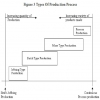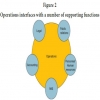Home | ARTS | Operations Management
|
Efficiency of the production process - Introduction to Operations Management
Operations Management - Introduction to Operations Management
Efficiency of the production process - Introduction to Operations Management
Posted On :
The creation of goods and services requires changing resources into goods and services.
Efficiency
of the production process
The creation of goods and services requires changing resources into goods and services. Productivity is used to indicate how good an operation is at converting inputs to outputs efficiently. The more efficiently we make this change the more productive we are. The production/operations manager’s job is to enhance (improve) this ratio of outputs to inputs.
It is the ratio of outputs (goods and service) divided by one or more inputs (such as labour, capital or management)
Productivity is a measure of operational performance. Thus improving productivity means improving efficiency. This improvement can be achieved in two ways:
1. Reduction in inputs while output remains constant, or
2. Increase in output while inputs remain constant.
Both represent an improvement in productivity. Production is the total goods and services produced. High Production may imply only that more people are working and that employment levels are high (low unemployment), but it does not imply high productivity.
Productivity measures can be based on a single input (Single-Factor Productivity or Partial Productivity) or on more than one input (Multi-Factor Productivity) or on all inputs. The choice depends on the purpose of the measurement.
It indicates the ratio of one resource (input) to the goods and services produced (outputs).
For example, for labour productivity, the single input to the operation would be employee hours.

Indicates the ratio of many or all resources (inputs) to the goods and services produced (outputs). When calculating multi-factor productivity, all inputs must be converted into a common unit of measure, typically cost.

The creation of goods and services requires changing resources into goods and services. Productivity is used to indicate how good an operation is at converting inputs to outputs efficiently. The more efficiently we make this change the more productive we are. The production/operations manager’s job is to enhance (improve) this ratio of outputs to inputs.
Productivity
It is the ratio of outputs (goods and service) divided by one or more inputs (such as labour, capital or management)
Productivity is a measure of operational performance. Thus improving productivity means improving efficiency. This improvement can be achieved in two ways:
2. Increase in output while inputs remain constant.
Both represent an improvement in productivity. Production is the total goods and services produced. High Production may imply only that more people are working and that employment levels are high (low unemployment), but it does not imply high productivity.
Productivity measures can be based on a single input (Single-Factor Productivity or Partial Productivity) or on more than one input (Multi-Factor Productivity) or on all inputs. The choice depends on the purpose of the measurement.
Single-factor Productivity
It indicates the ratio of one resource (input) to the goods and services produced (outputs).
For example, for labour productivity, the single input to the operation would be employee hours.

Multi-factor Productivity
Indicates the ratio of many or all resources (inputs) to the goods and services produced (outputs). When calculating multi-factor productivity, all inputs must be converted into a common unit of measure, typically cost.

Tags : Operations Management - Introduction to Operations Management
Last 30 days 936 views














